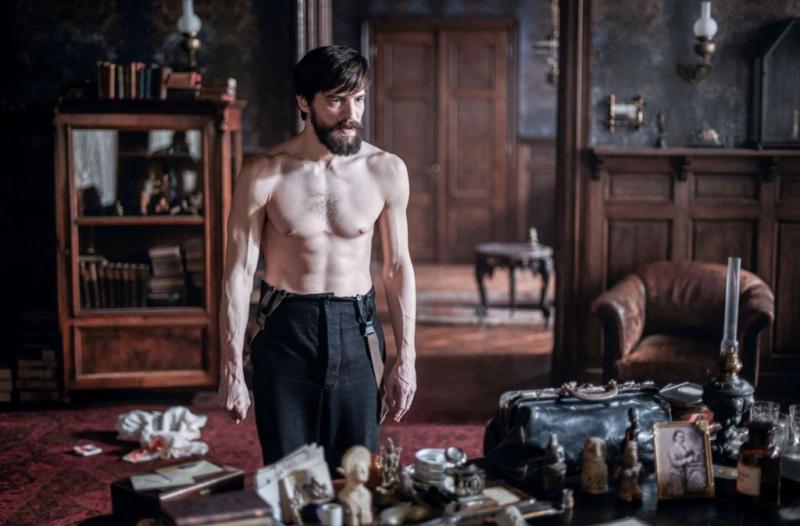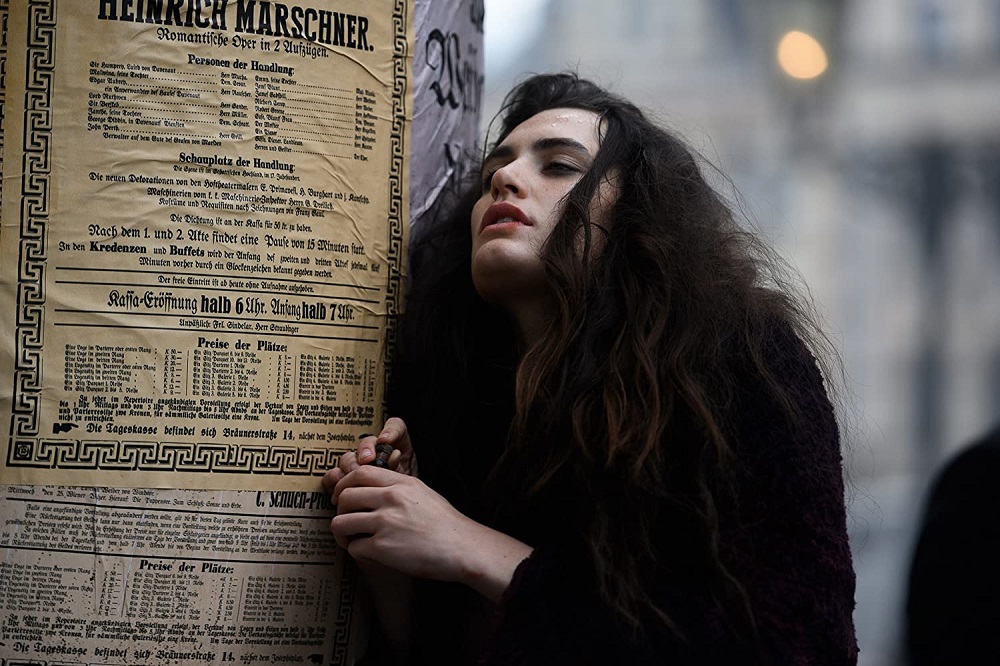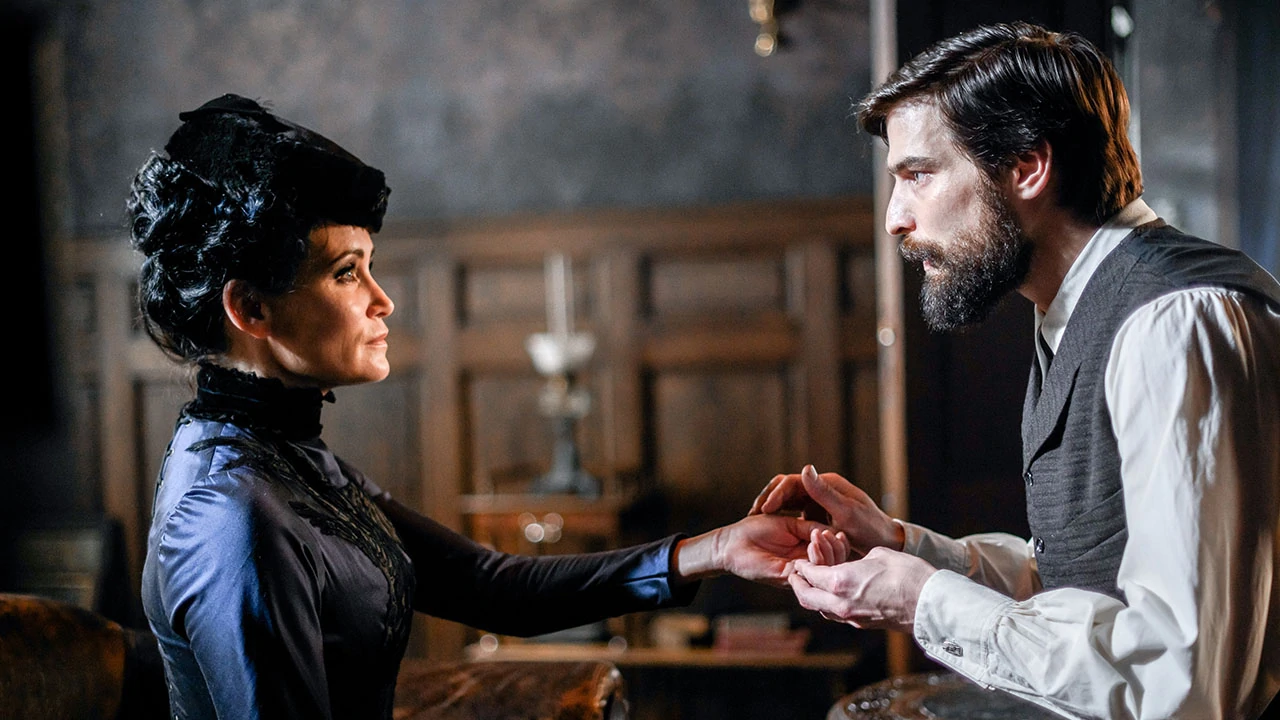Freud, Netflix review - hysteria and horror | reviews, news & interviews
Freud, Netflix review - hysteria and horror
Freud, Netflix review - hysteria and horror
Anything but a tame biopic of the Herr Professor Doktor's early professional life

Anyone expecting, as I was, a reverend and slightly earnest miniseries about Sigmund Freud's early professional years will be in for a surprise, and mostly in a good way.
Young Freud is handsome in the photographs; Robert Finster makes him sexy in a subdued, brooding and eventually tortured sort of way (and yes, he did take cocaine, believing it at the time to be non-addictive. He even recommend it to his fiancée, Martha Bernays, to bring some colour into her cheeks). The cameras are always good on eyes as mirrors of souls in various states of disturbance, and that helps us go with a rather unusual kind of hysteric patient in the shape of Fleur Salomé, a Hungarian raised as an instrument of revenge in the national cause (to say more would be the realm of a spoiler). Ella Rumpf (pictured below) is just as compelling as Finster; her versatility is stretched to the limits by the increasing wildness of the plot. There's also a stricken war veteran, Alfred Kiss, grippingly played by Georg Friedrich, and much is made of how madness and ritual co-existed in the Austrian army of the time. The further these three go into the labyrinth, the more is demanded of the actors - and they deliver.  In the second tier of characters are the compelling-bizarre von Szapárys who control Fleur – Anja Kling (pictured below with Finster) and Philipp Hochmair - offset in their weird intensity by the comic-stalwart sidekicks, the Herr Professor Doktor’s housekeeper Lenore (Brigitte Kren) and Kiss’s right hand man Poschacher (Christoph F. Krutzler). We also have, as in Babylon Berlin but not quite on that level of War and Peace-like believability, more real-life figures: older psychologists like Freud's antagonist Meynert and his supporter Breuer, whose broken-off analysis of Bertha Pappenheim ("Anna O.") informs the more outlandish Freud-Fleur “therapy”; later the introduction of crazy Crown Prince Rudolph and the dead hand of Emperor Franz Joseph I (and yes, the figure of Sissy, the Empress still absurdly mythologised by the Austrians, also makes a wraith-like appearance). Freud's Jewish family and bride-to-be also find themselves woven into the inner and outer worlds of the drama.
In the second tier of characters are the compelling-bizarre von Szapárys who control Fleur – Anja Kling (pictured below with Finster) and Philipp Hochmair - offset in their weird intensity by the comic-stalwart sidekicks, the Herr Professor Doktor’s housekeeper Lenore (Brigitte Kren) and Kiss’s right hand man Poschacher (Christoph F. Krutzler). We also have, as in Babylon Berlin but not quite on that level of War and Peace-like believability, more real-life figures: older psychologists like Freud's antagonist Meynert and his supporter Breuer, whose broken-off analysis of Bertha Pappenheim ("Anna O.") informs the more outlandish Freud-Fleur “therapy”; later the introduction of crazy Crown Prince Rudolph and the dead hand of Emperor Franz Joseph I (and yes, the figure of Sissy, the Empress still absurdly mythologised by the Austrians, also makes a wraith-like appearance). Freud's Jewish family and bride-to-be also find themselves woven into the inner and outer worlds of the drama. It comes as no surprise to learn that Prague was used for many of the outside locations, though Vienna in all its turn-of-the-century weirdness is a constant presence. The interiors seem meticulously observed, too, as I hope I can attest in the capacity of a former guide at London's Freud (House-) Museum and a visitor to what's left at the great man's Berggasse 19 apartment; at the time the film purports to cover, he was living in the Sühnhaus, a large apartment block built on the site of the Ringtheater, the destruction of which by fire, leading to 400 deaths is woven into the plot. That it was ill-starred would seem to be confirmed by the fact that one of Freud’s patents jumped to her death from the inner staircase – he moved after that. The reality lulls you into a false sense of stability, but by Episode Four the Shiraz rug is pulled so violently from under your feet that suspension of disbelief becomes briefly difficult. And some may find it hard to go on after Episode Six, which is extremely bloody and preposterous. Stick with it; the classy rewards outweigh the ludicrous.
It comes as no surprise to learn that Prague was used for many of the outside locations, though Vienna in all its turn-of-the-century weirdness is a constant presence. The interiors seem meticulously observed, too, as I hope I can attest in the capacity of a former guide at London's Freud (House-) Museum and a visitor to what's left at the great man's Berggasse 19 apartment; at the time the film purports to cover, he was living in the Sühnhaus, a large apartment block built on the site of the Ringtheater, the destruction of which by fire, leading to 400 deaths is woven into the plot. That it was ill-starred would seem to be confirmed by the fact that one of Freud’s patents jumped to her death from the inner staircase – he moved after that. The reality lulls you into a false sense of stability, but by Episode Four the Shiraz rug is pulled so violently from under your feet that suspension of disbelief becomes briefly difficult. And some may find it hard to go on after Episode Six, which is extremely bloody and preposterous. Stick with it; the classy rewards outweigh the ludicrous.
rating
Explore topics
Share this article
The future of Arts Journalism
You can stop theartsdesk.com closing!
We urgently need financing to survive. Our fundraising drive has thus far raised £49,000 but we need to reach £100,000 or we will be forced to close. Please contribute here: https://gofund.me/c3f6033d
And if you can forward this information to anyone who might assist, we’d be grateful.

Subscribe to theartsdesk.com
Thank you for continuing to read our work on theartsdesk.com. For unlimited access to every article in its entirety, including our archive of more than 15,000 pieces, we're asking for £5 per month or £40 per year. We feel it's a very good deal, and hope you do too.
To take a subscription now simply click here.
And if you're looking for that extra gift for a friend or family member, why not treat them to a theartsdesk.com gift subscription?
more TV
 Blu-ray: The Sweeney - Series One
Influential and entertaining 1970s police drama, handsomely restored
Blu-ray: The Sweeney - Series One
Influential and entertaining 1970s police drama, handsomely restored
 I Fought the Law, ITVX review - how an 800-year-old law was challenged and changed
Sheridan Smith's raw performance dominates ITV's new docudrama about injustice
I Fought the Law, ITVX review - how an 800-year-old law was challenged and changed
Sheridan Smith's raw performance dominates ITV's new docudrama about injustice
 The Paper, Sky Max review - a spinoff of the US Office worth waiting 20 years for
Perfectly judged recycling of the original's key elements, with a star turn at its heart
The Paper, Sky Max review - a spinoff of the US Office worth waiting 20 years for
Perfectly judged recycling of the original's key elements, with a star turn at its heart
 The Guest, BBC One review - be careful what you wish for
A terrific Eve Myles stars in addictive Welsh mystery
The Guest, BBC One review - be careful what you wish for
A terrific Eve Myles stars in addictive Welsh mystery
 theartsdesk Q&A: Suranne Jones on 'Hostage', power pants and politics
The star and producer talks about taking on the role of Prime Minister, wearing high heels and living in the public eye
theartsdesk Q&A: Suranne Jones on 'Hostage', power pants and politics
The star and producer talks about taking on the role of Prime Minister, wearing high heels and living in the public eye
 King & Conqueror, BBC One review - not many kicks in 1066
Turgid medieval drama leaves viewers in the dark
King & Conqueror, BBC One review - not many kicks in 1066
Turgid medieval drama leaves viewers in the dark
 Hostage, Netflix review - entente not-too-cordiale
Suranne Jones and Julie Delpy cross swords in confused political drama
Hostage, Netflix review - entente not-too-cordiale
Suranne Jones and Julie Delpy cross swords in confused political drama
 In Flight, Channel 4 review - drugs, thugs and Bulgarian gangsters
Katherine Kelly's flight attendant is battling a sea of troubles
In Flight, Channel 4 review - drugs, thugs and Bulgarian gangsters
Katherine Kelly's flight attendant is battling a sea of troubles
 Alien: Earth, Disney+ review - was this interstellar journey really necessary?
Noah Hawley's lavish sci-fi series brings Ridley Scott's monster back home
Alien: Earth, Disney+ review - was this interstellar journey really necessary?
Noah Hawley's lavish sci-fi series brings Ridley Scott's monster back home
 The Count of Monte Cristo, U&Drama review - silly telly for the silly season
Umpteenth incarnation of the Alexandre Dumas novel is no better than it should be
The Count of Monte Cristo, U&Drama review - silly telly for the silly season
Umpteenth incarnation of the Alexandre Dumas novel is no better than it should be
 The Narrow Road to the Deep North, BBC One review - love, death and hell on the Burma railway
Richard Flanagan's prize-winning novel becomes a gruelling TV series
The Narrow Road to the Deep North, BBC One review - love, death and hell on the Burma railway
Richard Flanagan's prize-winning novel becomes a gruelling TV series
 The Waterfront, Netflix review - fish, drugs and rock'n'roll
Kevin Williamson's Carolinas crime saga makes addictive viewing
The Waterfront, Netflix review - fish, drugs and rock'n'roll
Kevin Williamson's Carolinas crime saga makes addictive viewing

Add comment